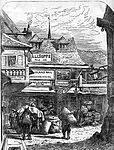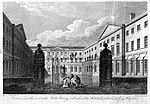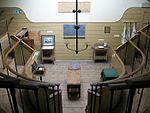The George Inn, Southwark
1676 establishments in England17th-century architecture in the United KingdomBuildings and structures completed in 1676Coaching innsGrade I listed buildings in the London Borough of Southwark ... and 9 more
Grade I listed pubs in LondonNational Inventory PubsNational Trust properties in LondonPubs in the London Borough of SouthwarkSaint George and the DragonTimber framed buildings in LondonTimber framed pubs in EnglandTourist attractions in the London Borough of SouthwarkUse British English from August 2015

The George Inn, or The George, is a public house established in the medieval period on Borough High Street in Southwark, London, owned and leased by the National Trust. It is located about 250 metres (820 ft) from the south side of the River Thames near London Bridge and is the only surviving galleried London coaching inn.
Excerpt from the Wikipedia article The George Inn, Southwark (License: CC BY-SA 3.0, Authors, Images).The George Inn, Southwark
Borough High Street, London Borough (London Borough of Southwark)
Geographical coordinates (GPS) Address Phone number Website External links Nearby Places Show on map
Geographical coordinates (GPS)
| Latitude | Longitude |
|---|---|
| N 51.504182 ° | E -0.090021 ° |
Address
George Inn (The George)
Borough High Street 75-77
SE1 1NH London, Borough (London Borough of Southwark)
England, United Kingdom
Open on Google Maps









